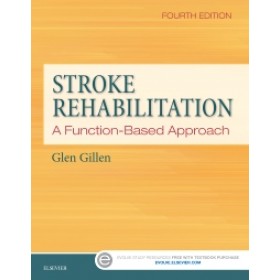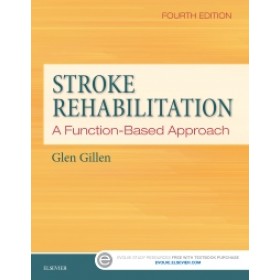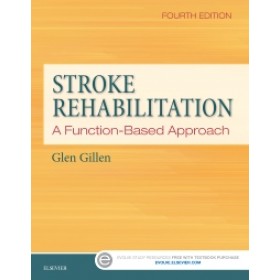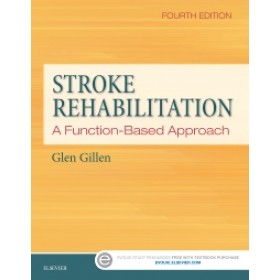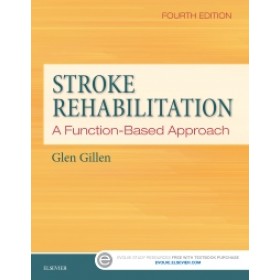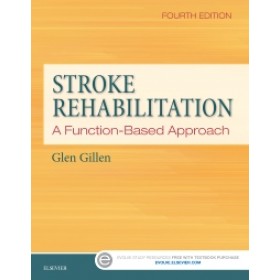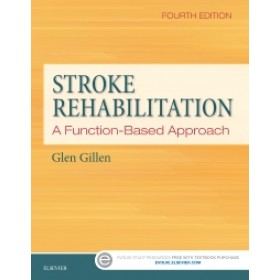Details
Stroke Rehabilitation: A Function-Based Approach, 4th Edition: Module 6
SKU: 786
by Glen Gillen, EdD, OTR, FAOTA
These courses are offered in cooperation with Elsevier Health and utilize the hardback textbook, “Stroke Rehabilitation: A Function-Based Approach, 4th Edition” by Glen Gillen, EdD, OTR, FAOTA.
Learn to confidently manage the growing number of stroke rehabilitation clients with these exciting new courses! Using a holistic and multidisciplinary approach, this text remains the only comprehensive, evidence-based stroke rehabilitation resource for occupational therapists. The new edition has been extensively updated with the latest research in assessment and intervention, along with more evidence-based research added to every chapter. As with previous editions, this comprehensive reference uses an application-based method that integrates background medical information, samples of functionally based evaluations, and current treatment techniques and intervention strategies.
Module 1: covers pathophysiology, medical management and acute rehabilitation of stroke survivors, psychological aspects of stroke rehabilitation and improving participation and quality of live through occupation.
Module 2: covers the task-orientated approach, activity-based interventions in stroke rehabilitation and approaches to motor control dysfunction.
Module 3: covers trunk control, balance impairments and vestibular rehabilitation when performing stroke rehabilitation.
Module 4: covers upper extremity function and management and rehabilitation technologies to promote upper limb recovery after a stroke.
Module 5: covers edema control, splinting applications and functional mobility after a stroke.
Module 6: covers gait awareness, managing visual and visuospatial impairments to optimize function in patient who have had strokes and the impact of neurobehavioral deficits on activities of daily living.
Module 7: covers enhancing the performance of activities of daily living after a stroke, the treatment of cognitive-perceptual deficits using a function-based approach and managing speech and language deficits after a stroke.
Module 8: covers driving and community mobility as an instrumental activity of daily living, parenting after stroke, dysphagia management and sexual function and intimacy after a stroke.
Module 9 covers adaptations for activities of daily living, leisure activity participation after stroke, seating and wheeled mobility prescription and home evaluation and modifications for stroke patients.
Course Length: 8.0 contact hours
Instructional level: Intermediate
This package contains the reading and testing materials for Module 6 only.
Stroke Rehabilitation: A Function-Based Approach, 4th Edition: Module 6
Course Goals and Objectives:
Course Goals: This course is intended to instruct the student, through self-paced study, on gait awareness, managing visual and visuospatial impairments to optimize function in patients who have had strokes and the impact of neurobehavioral deficits on activities of daily living.
Student Objectives:
At the end of this course, the student will be able to:
1. Analyze the components of normal gait
2. Identify common gait deviations after a stroke
3. Analyze the basics of gait retraining, including common outcome measures used to demonstrate improvement.
4. Identify how proprioceptive, visual and/or perceptual deficits from a stroke may affect gait.
5. Identify and analyze commonly used orthoses and assistive devices for gait based on a stroke patient’s needs.
6. Identify how visual information is processed by the central nervous system.
7. Differentiate between 9 visual skills and their associated functions and resulting dysfunctions after stroke.
8. Identify 5 components of a vision screening.
9. Identify the etiology, frequency of occurrence in stroke patients and possible interventions for hemianopsia
10. Identify the etiology and best treatment interventions for diplopia in stroke patients.
11. Differentiate between 5 visual-spatial skills and their relationship to functional activities.
12. Identify elements of neurobehavior in regards to sensory stimuli, CNS processing and behavioral responses.
13. Differentiate between the functional localization for neurologic process of body functions from a cerebral cortical level.
14. Differentiate between conceptual and operational impairments based on cortical impairments and anatomic location.
15. Identify cortical disorders that may be observable in person hygiene and grooming, dressing, eating and functional mobility
16. Identify training requirements for therapists to utilize the A-ONE and the Assessment of Motor and Process Skills standardized assessments.
